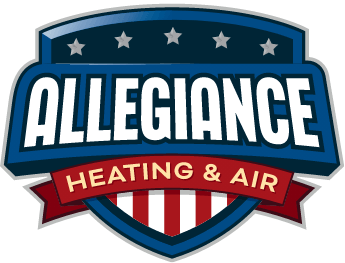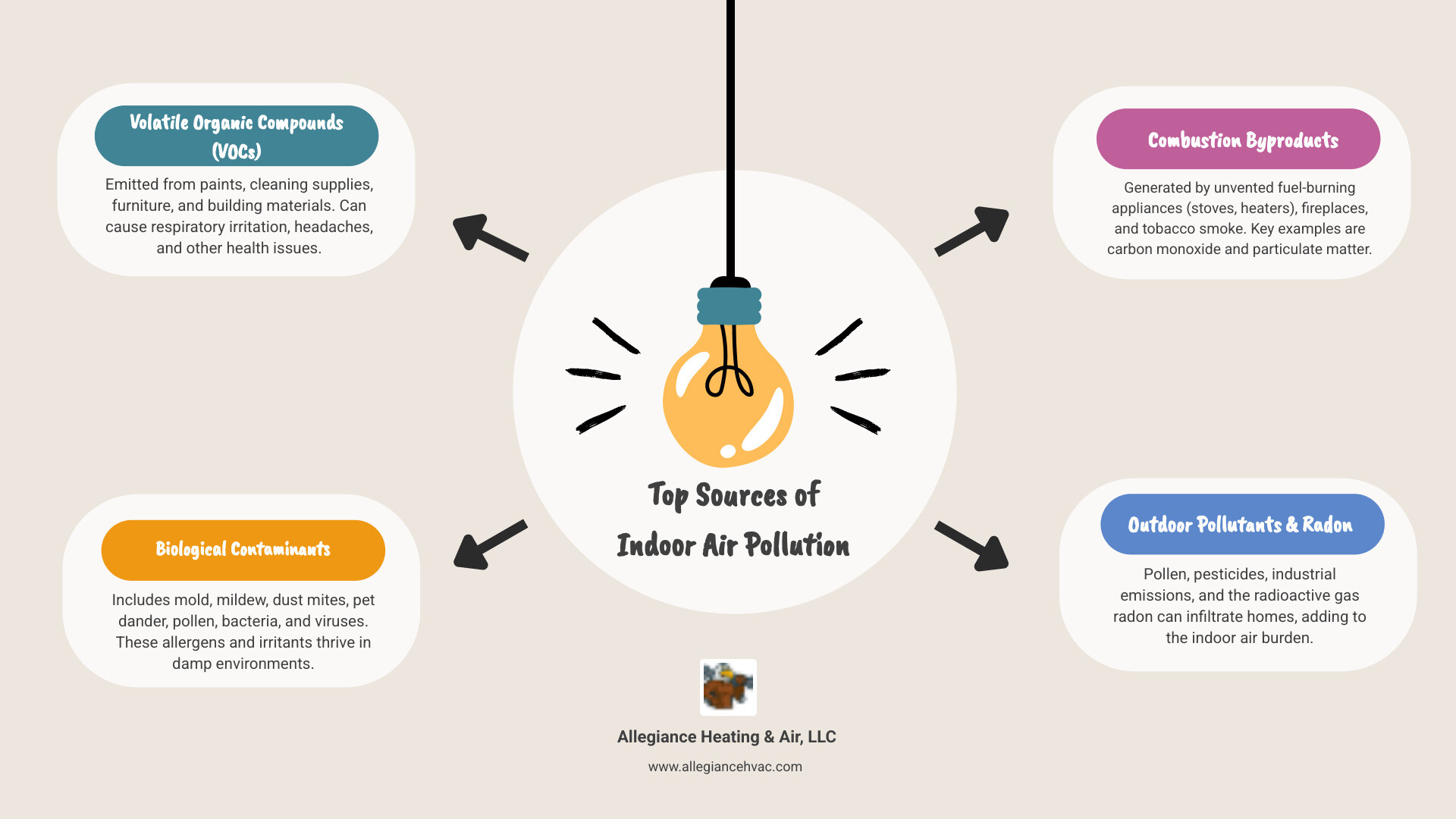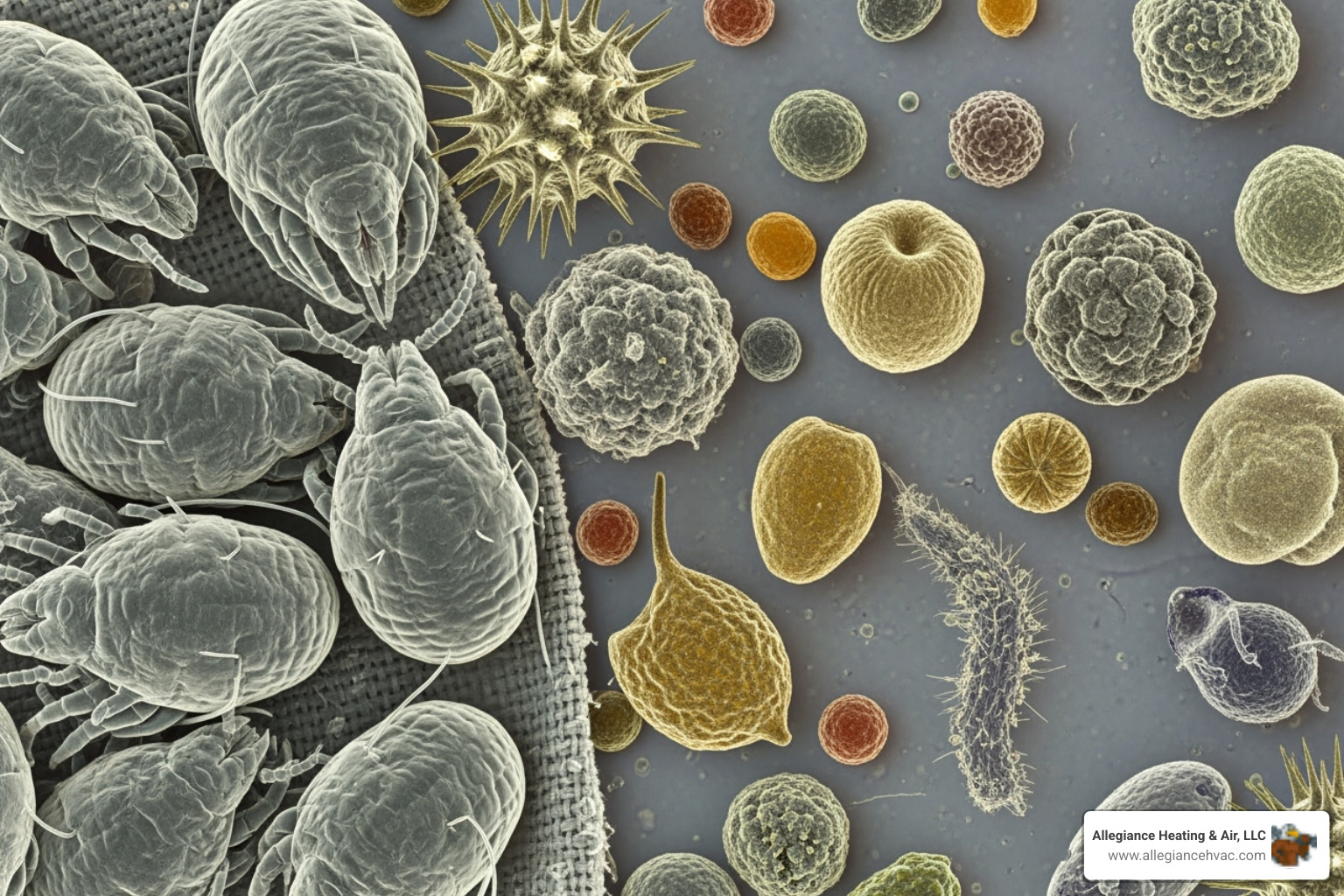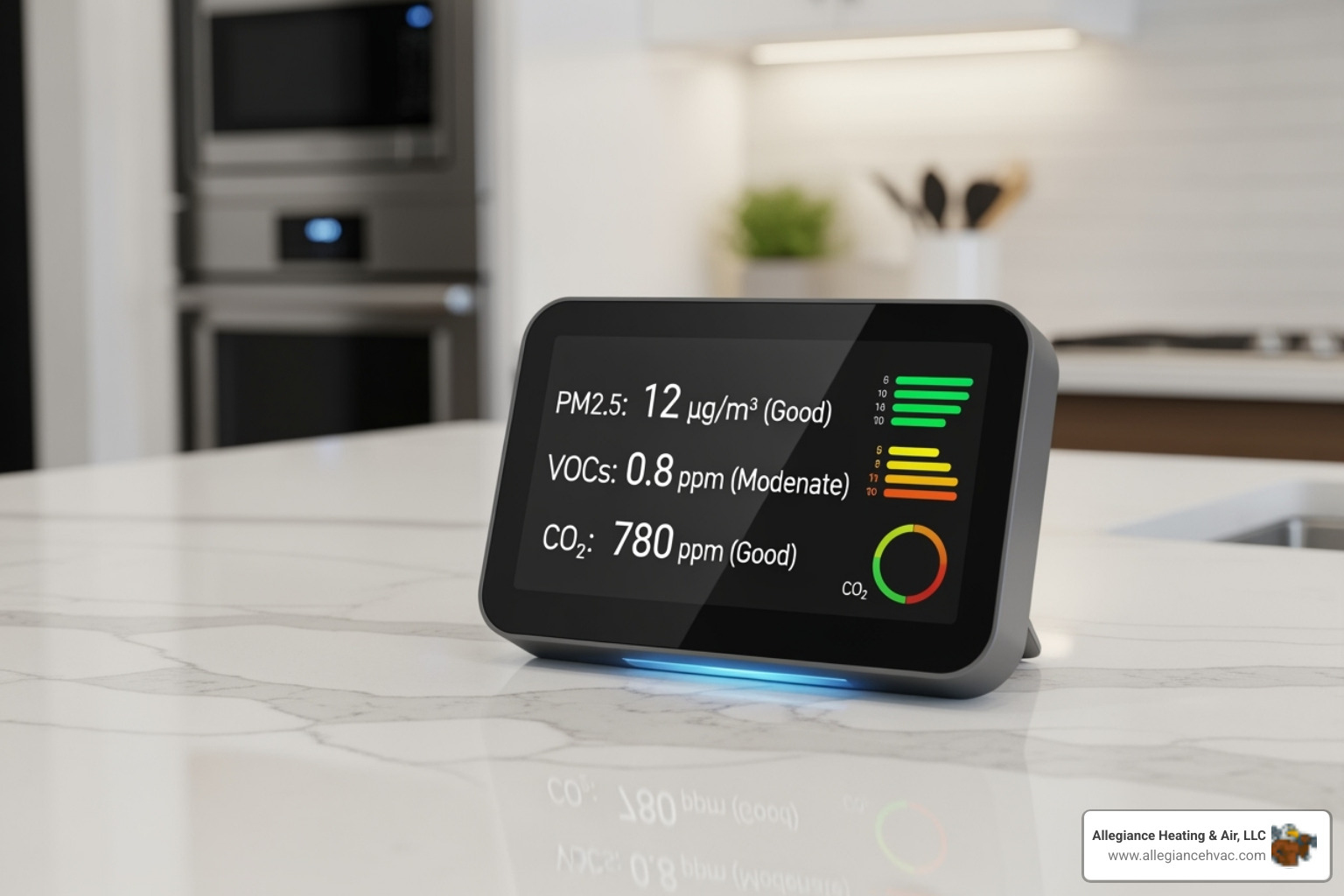Why the Air Inside Matters More Than You Think
Indoor air quality solutions can transform your home from stuffy and unhealthy to fresh and comfortable. The air inside your home directly affects your family’s health, energy, and well-being.
Quick Indoor Air Quality Solutions:
- Source Control: Use low-VOC products, control moisture, maintain cleanliness
- Improved Ventilation: Install exhaust fans, use ERVs/HRVs, open windows when possible
- Air Cleaning: Upgrade HVAC filters, add air purifiers, consider UV systems
- Humidity Control: Maintain 30-50% humidity with whole-home systems
- Professional Assessment: Test for radon, CO, and other pollutants
Here’s a startling fact: indoor air can be 2-5 times more polluted than outdoor air—and in some cases, over 100 times worse. Since we spend about 90% of our time indoors, this is a critical health issue.
Poor indoor air quality can trigger allergies, worsen asthma, cause headaches, and reduce productivity. The good news is that you have more control over your indoor air than you might think.
The key is a three-part strategy: controlling pollution sources, improving ventilation, and cleaning the air that circulates through your home.
The Invisible Intruders: Identifying Common Indoor Pollutants
Even a spotless home can have a hidden world of microscopic air pollutants. These invisible intruders sneak in through windows, hide in furniture, and multiply in damp areas. Understanding these unwelcome guests is the first step toward effective indoor air quality solutions.
Indoor air pollution comes from three main sources: outdoor air, the people living in your home, and everyday items and activities.
Volatile Organic Compounds (VOCs) are sneaky indoor pollutants. The “new car smell” is a prime example of VOCs at work. These gases escape from paint, cleaning supplies, air fresheners, and furniture. High VOC levels can cause fatigue and headaches.
Dust mites are microscopic creatures that thrive in warm, humid spots, feeding on shed skin cells. While invisible, their impact on allergies and asthma is significant.
Pet dander consists of tiny flecks of skin shed by our furry friends. Even well-groomed pets shed dander, a major allergen causing sneezing, watery eyes, and respiratory issues.
Mold and mildew are fungi that grow in damp corners and bathrooms. They release spores into the air that can trigger allergic reactions and respiratory problems.
Bacteria and viruses turn your home’s air into a highway for illness. Poor ventilation allows these airborne pathogens to spread quickly, leading to more sick days.
Particulate matter includes tiny airborne particles like dust, pollen, and smoke. The smallest particles (PM2.5) are the most concerning, as they can bypass the body’s defenses and enter the bloodstream.
Poor indoor air quality can impact your family’s health and reduce energy levels. To learn more about how these unseen threats can affect your well-being, explore our resources on Poor Indoor Air Quality on Health.
The Silent Dangers: Radon and Carbon Monoxide
Two pollutants deserve special attention because they are dangerous and undetectable without proper equipment: radon and carbon monoxide.
Radon is a colorless, odorless, radioactive gas that forms naturally from uranium in soil and rock. It can slip through cracks in your foundation, walls, and floors. Long-term exposure to high radon levels is the second leading cause of lung cancer after smoking. The only way to know if your home has a radon problem is through radon testing. If levels are high, mitigation systems can safely vent the gas outdoors.
Carbon monoxide is known as the “silent killer.” This deadly, colorless, and odorless gas forms from the incomplete combustion of fuels like natural gas, propane, oil, or wood. Common carbon monoxide sources include furnaces, water heaters, gas stoves, and fireplaces. Early symptoms mimic the flu (nausea, fatigue, dizziness), but high-level exposure can cause organ damage or death.
Every home needs CO detectors on each floor and near sleeping areas. These devices are a vital early warning system. For more critical information, visit our page on Carbon Monoxide Poisoning.
Allergens and Irritants
Beyond radon and CO, your air likely contains allergens and irritants that can make daily life miserable for sensitive individuals.
Pollen might seem like an outdoor problem, but it easily finds its way inside. It drifts in through open windows and gets tracked in on clothing, shoes, and pets.
Pet dander continues to be a major issue for many. The constant shedding of these tiny skin flakes can trigger sneezing, itchy eyes, and breathing difficulties.
Smoke from tobacco, cooking, or wildfires carries harmful particles and VOCs that degrade air quality.
Cleaning chemicals can be an ironic problem. Many products release irritating VOCs that can cause headaches and respiratory issues.
For families in Greenville, IN, Louisville, KY, and the surrounding areas, seasonal allergies combined with indoor irritants can make homes a source of discomfort. Improving your indoor air quality is one of the most effective ways to manage allergy and asthma symptoms. To see how air purification can help, check out our guide on How Air Purification Can Help with Allergies.
The Three Pillars of Purer Air: Control, Ventilate, and Clean
Improving your home’s air quality isn’t about a single gadget; it’s about creating a system that works together. The most effective indoor air quality solutions rest on three pillars: controlling pollution sources, improving ventilation, and cleaning the air.
These three strategies work in tandem. Even the best air purifier is ineffective without source control and proper ventilation. When all three pillars work together, they create a powerful defense against indoor air pollution.
The Environmental Protection Agency has developed comprehensive guidance on this three-pronged approach, which you can explore in their resource on How to Improve Indoor Air Quality.
Pillar 1: Source Control and Reduction
Source control is often the most effective and budget-friendly way to improve indoor air quality. It’s more efficient to stop pollutants at the source.
When shopping, look for low-VOC or no-VOC paint, cleaning supplies, and furniture. Many products now carry certifications for low emissions.
Regular cleaning makes a big difference. Dust with a damp cloth to trap particles. A vacuum with a HEPA filter can capture dust mites, pet dander, and other tiny allergens. Wash bedding weekly in hot water to kill dust mites.
For homes with pets, regular grooming significantly reduces dander. Brushing pets outside prevents allergens from entering the home.
Moisture control is crucial for preventing problems like mold. Fix leaks promptly, use exhaust fans when cooking or showering, and keep humidity levels between 30-50%. For detailed strategies, check out our guide on Proper Humidity Control Importance.
While houseplants like English Ivy and Peace Lily can absorb some toxins, their overall air-purifying effect is minimal. Enjoy them for their beauty, but don’t rely on them as your primary air cleaning strategy.
Pillar 2: The Power of Ventilation
Ventilation is about getting stale air out and fresh air in. It’s a powerful way to dilute indoor pollutants and maintain healthy air circulation.
Natural ventilation costs nothing. Opening windows and doors on pleasant days creates refreshing cross-ventilation. Check outdoor air quality first to avoid bringing in pollutants like wildfire smoke or high pollen.
Most HVAC systems recirculate indoor air, not bring in fresh air. This is where mechanical ventilation is valuable. Exhaust fans in bathrooms and kitchens are your first line of defense, removing moisture and pollutants at the source.
For more comprehensive ventilation, Energy Recovery Ventilators (ERVs) and Heat Recovery Ventilators (HRVs) are game-changers. These systems bring in fresh air while recovering energy from the outgoing stale air. ERVs transfer both heat and humidity, making them ideal for our humid climate in Southern Indiana and Kentucky. HRVs primarily transfer heat, working better in colder climates.
These systems maintain comfort while reducing energy costs. The Department of Energy’s Energy Saver: Whole-House Ventilation guide provides technical details, and you can learn more about their benefits on our page about Whole Home Ventilators Importance.
Pillar 3: Air Cleaning and Filtration
After controlling sources and improving ventilation, the final pillar is actively cleaning the air. This is where air cleaning and filtration systems shine.
HVAC system filters are your home’s primary air cleaning workhorses. Upgrading your HVAC filter is a simple, effective improvement.
Portable air purifiers work well for targeting specific rooms like bedrooms or home offices.
Whole-home air cleaning systems integrate with your HVAC system, cleaning all the air that passes through your ductwork for comprehensive purification.
Air cleaners excel at capturing particles but are generally not designed for gaseous pollutants like VOCs. This is why all three pillars are necessary: source control and ventilation handle gases, while air cleaning captures particles. The effectiveness of an air cleaner depends on its capture efficiency and the volume of air it can process. To understand the available technologies, explore our guide on Different Types of Air Cleaners and Their Benefits.
A Deep Dive into Professional Indoor Air Quality Solutions
While DIY steps help, professional indoor air quality solutions offer a more comprehensive and lasting impact. Professional HVAC companies like Allegiance Heating & Air understand that every home is unique.
We assess your specific situation and recommend solutions that integrate seamlessly with your heating and cooling system. Professional solutions work behind the scenes through your ductwork, cleaning and conditioning all the air in your home efficiently and unobtrusively.
Air Filtration Systems: Your Home’s First Line of Defense
Your HVAC filter is your home’s first line of defense against airborne particles. Understanding MERV ratings helps you choose the right level of protection. MERV (Minimum Efficiency Reporting Value) rates filter effectiveness on a scale of 1-20.
For most local homes, we recommend MERV 11+ filters to balance high-efficiency filtration with proper airflow.
HEPA filters are the gold standard, capturing 99.97% of particles as small as 0.3 microns. They are often found in portable purifiers or specialized whole-home systems.
Pleated media filters have more surface area than flat filters, improving efficiency and lifespan.
It’s crucial to follow filter replacement schedules. A dirty filter restricts airflow, forcing your HVAC system to work harder and increasing energy bills. A 1-inch pleated filter needs replacing every 30-60 days, while thicker 4-inch or 6-inch filters can last 6-12 months. Homes with pets or allergy sufferers may need more frequent changes. For comprehensive solutions, explore our Whole-Home Air Filtration options. Replacing Your Air Filter is a simple, vital maintenance task.
| MERV Rating | Particles Captured |
|---|---|
| 1-4 | Large particles: dust, lint, pollen |
| 5-8 | Mold spores, dust mites, pet dander |
| 9-12 | Fine particles: legionella, lead dust, humidifier dust |
| 13-16 | Very fine particles: bacteria, tobacco smoke, some viruses |
Air Purification Technologies
Modern air purifiers use advanced technologies to target specific pollutants.
UV germicidal lamps use ultraviolet light to neutralize viruses, bacteria, and mold spores in your ductwork. UV systems also keep your evaporator coils clean, preventing mold and bacteria growth at the source. Learn more on our Ultraviolet Air Cleaners Improved IAQ page.
Bipolar ionization introduces charged ions into your air that attach to airborne particles, making them larger and easier to filter. These ions also neutralize viruses, bacteria, and odors throughout your home, even on surfaces.
Photocatalytic oxidation (PCO) systems use UV light and a catalyst to break down VOCs, odors, and chemical contaminants into harmless water vapor and carbon dioxide.
Activated carbon filters specialize in absorbing gaseous pollutants and odors that particulate filters can’t touch, such as VOCs and cooking smells.
Humidity Control: Finding the Right Balance
Proper humidity control is crucial for indoor air quality. The ideal range is 30-50% humidity.
High humidity fosters mold, dust mites, and bacteria, making the air feel sticky and uncomfortable. Low humidity, common in winter, causes dry skin, irritated sinuses, static electricity, and can damage wood furnishings.
Whole-home humidifiers integrate with your HVAC system to solve dry air problems. Unlike portable units, they add moisture evenly throughout your home without constant refilling. See how they can improve comfort on our Whole-Home Humidifiers page.
Whole-home dehumidifiers tackle excess moisture from our humid climate, preventing mold growth and helping your air conditioner operate more efficiently.
Know Your Air: Assessment, Monitoring, and Maintenance
Just as you monitor a car’s fuel gauge, you should monitor your home’s air. Understanding your indoor air quality is the crucial first step toward creating a healthier home.
Proactive monitoring acts as an early warning system, alerting you to rising humidity or CO2 levels before they become serious problems.
Choosing the Right Indoor Air Quality Solutions for Your Home
Smart IAQ monitors continuously track pollutants like particulate matter (PM2.5), VOCs, carbon dioxide, temperature, and humidity. They send alerts to your smartphone, showing how activities like cooking or cleaning affect your air.
Carbon monoxide and radon detectors are absolute essentials. These life-saving devices should be certified and tested regularly, as CO and radon are otherwise undetectable.
For a deeper analysis, professional testing services offer comprehensive reports with actionable recommendations. This is valuable for persistent odors, suspected mold, or unexplained health symptoms. You can learn more about our approach through our Home Air Quality Test services.
DIY vs. Professional Indoor Air Quality Solutions
Many homeowners ask what they can do themselves versus when to call a professional.
Simple DIY steps can make a surprising difference. Changing HVAC filters is the most impactful DIY task. Other easy steps include keeping your home clean, using exhaust fans, opening windows when outdoor air is clean, and choosing low-VOC products.
Call professionals for persistent problems or comprehensive solutions. Our technicians at Allegiance Heating & Air, LLC have the specialized training and equipment to tackle complex IAQ challenges. We perform detailed assessments to identify root causes and integrate whole-home Indoor air quality solutions with your HVAC system.
Professional installation ensures optimal performance and energy efficiency. We also provide ongoing maintenance, a preventative approach that protects your family’s health and your home. Our team can help you choose solutions for your specific situation in Greenville, IN, or across Southern Indiana and Kentucky. For more details, visit our Professional Home Air Quality Testing page.
Breathe Easy with Expert Help
You should be able to breathe easy in your own home. Understanding indoor pollutants—from VOCs and dust mites to radon and carbon monoxide—shows that indoor air quality solutions are essential for your family’s health and comfort.
The path to cleaner air is clear. The three pillars—source control, proper ventilation, and air cleaning systems—work together to create a powerful defense against indoor air pollution.
Simple DIY steps like changing filters or using low-VOC cleaners can make a difference. But for effective, long-lasting results, professional expertise is key.
At Allegiance Heating & Air, LLC, we’ve helped families in Greenville, IN, Louisville, KY, and throughout the Kentuckiana region breathe easier since 2005. As a family-owned business, we know your home is your sanctuary. Our highly vetted technicians assess your home and recommend customized solutions that integrate with your HVAC system.
Whether you need comprehensive air quality testing, whole-home filtration, humidity control, or UV purification, we’re here to help you create the healthiest indoor environment possible.
Ready to transform your home’s air quality? For a comprehensive assessment and custom IAQ strategy for your home, contact our team of trusted experts today. Let’s work together to make sure every breath you take at home is fresh and clean.








